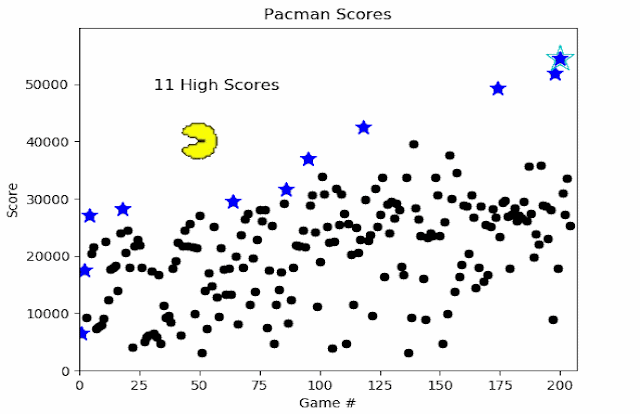What I Learned from 200 Games of Pac-Man, Part 2: Personal Progress
Controls
My early plays revolved around battling the joystick emulation. Using an XBOX-style controller, I tried controlling Pac-Man with both the standard finger joystick and the D-pad, but found myself frequently getting moved in directions I didn't intend. Here are the results from those games:
I was able to play competently enough, breaking 20,000 points about a third of the time, but too large a fraction of my deaths were coming from controller issues, so I decided to switch things up a bit. I suspected there was an issue with the diagonal commands, so I tried setting up the A-B-X-Y buttons to issue directional commands, like so:
I was able to play competently enough, breaking 20,000 points about a third of the time, but too large a fraction of my deaths were coming from controller issues, so I decided to switch things up a bit. I suspected there was an issue with the diagonal commands, so I tried setting up the A-B-X-Y buttons to issue directional commands, like so:
Unfortunately, this didn't go so well either.
I barely achieved a new high score at around game 65, but my overall performance didn't seem to be improving very much, if at all. Yes, I fixed the problem of issuing accidental commands, but sacrificed the ability to quickly change direction. There was just no natural way to quickly move between all four buttons with one finger... and using multiple fingers required too steep a learning curve for my taste.
I eventually stumbled on the joystick map parameter in MAME, which I already detailed in a previous blog entry. This allowed me to set up a more reasonable control scheme with the left finger joystick. I went with the standard 4-way joystick map, denoted in shorthand as s8.4s8.44s8.4445, and used that for the remainder of my games.
I barely achieved a new high score at around game 65, but my overall performance didn't seem to be improving very much, if at all. Yes, I fixed the problem of issuing accidental commands, but sacrificed the ability to quickly change direction. There was just no natural way to quickly move between all four buttons with one finger... and using multiple fingers required too steep a learning curve for my taste.
I eventually stumbled on the joystick map parameter in MAME, which I already detailed in a previous blog entry. This allowed me to set up a more reasonable control scheme with the left finger joystick. I went with the standard 4-way joystick map, denoted in shorthand as s8.4s8.44s8.4445, and used that for the remainder of my games.
Score Growth
To get a better sense for how I was improving with time, I calculated the average of my scores in 20-game intervals. The resulting curve is plotted below in red.
My average score improved from about 15,000 points to about 30,000 in 200 games, making for an improvement of about 75 points per game. If I continued at this rate, it would take about 13,000 games to reach 1 million points (the maximum possible is 3,333,360). That would be quite a time commitment!
In reality, though, it probably wouldn't take that long. The best Pac-Man players rely on predetermined ghost evasion patterns, many of which can be applied across multiple levels. Even if I didn't rely on patterns determined by other people, it's likely I would discover some of my own. You may have noticed in the plot above that the last ~50 games I played have more consistent scores than the previous 150. That's because I began following patterns that I had stumbled on just by repeated playing.
High Score Counts
Another way to measure my improvement in Pac-Man is to count how many high scores I achieved. As I noted in my previous blog entry, You Beat Your High Score, But Are You Getting Better?, the number of high scores you expect to achieve in a game where you're not improving has a fairly low ceiling. For 200 games, the typical number you'd expect in a game with random outcomes is 6. My 11 high scores were considerably more than that, and enough that I could say with about 98% confidence that my scores were improving and not just a result of randomness.
Final Impressions
The arcade version of Pac-Man is really hard. This is pretty typical of arcade games, of course, but Pac is a step above even your average arcade fare. Unless you're memorizing patterns found by other people, improving as a Pac-Man player requires vast amounts of trial and error. I have heard from several players that they just didn't think they were improving as they played, and given how much scatter there was in my scores, it would have been easy for me to reach the same conclusion if I had stopped after 50 or even 100 games. Still, I did improve, and fairly steadily, at that. I suspect others would as well, but whether that is worth the commitment is really up to you.
The final installment of my Pac-Man series will be a full review, covering its potential aesthetic significance to a gamer in the 21st century, and answering the question, "Should I really bother devoting significant time to this when Red Dead Redemption 2 is only $40 at Wal-Mart?"






Thanks for your part 1 and part 2 write ups. Do the same for ms. pac-man. Have a great 2021
ReplyDeleteThanks for your write-up of your experience. Now do the same for Ms. Pac-man. Have a great 2021
ReplyDelete